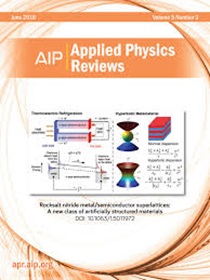Ultralow cyclic and device variability memristors via deterministic resistive switching in phase segregated nickel nanofilaments
IF 11.9
1区 物理与天体物理
Q1 PHYSICS, APPLIED
引用次数: 0
Abstract
Memristor crossbar arrays, mimicking the human brain, hold immense potential for energy-efficient data-intensive computations in artificial intelligence applications such as image recognition and natural language processing. However, the stochastic nature of resistive switching (RS) in memristors often leads to poor device stability and uniformity, hindering the scalability required for real-world applications. Here, we present a novel phase segregation strategy to achieve uniformly distributed self-assembled Ni nanofilaments within a BaTiO3 matrix, enabling local deterministic redox reactions for RS, as confirmed by comprehensive structural, local, and macroscopic RS studies. This approach yields drastic enhancement in cyclic performance and device uniformity, with the average cyclic variances of Set voltage and low resistance state down to 1.4% and 9.6%, respectively. The devices also exhibit excellent endurance (109 cycles) and ultrafast programming speed (down to 100 ns) and achieve over 5-bit level long-term memory states. The enhanced cyclic stability and device uniformity translate to high training and learning accuracies (95%) in a three-level deep neural network, with 1-bit inputs. Our phase segregation strategy provides a generic pathway to overcome the long-standing challenge of device variability in neuromorphic computing.基于相位分离镍纳米丝的确定性电阻开关的超低循环和器件可变性忆阻器
忆阻器交叉棒阵列,模仿人类大脑,在图像识别和自然语言处理等人工智能应用中具有巨大的节能数据密集型计算潜力。然而,忆阻器中电阻开关(RS)的随机性往往导致器件稳定性和均匀性差,阻碍了实际应用所需的可扩展性。在这里,我们提出了一种新的相分离策略,可以在BaTiO3基质中实现均匀分布的自组装Ni纳米丝,从而实现RS的局部确定性氧化还原反应,这已经得到了全面的结构、局部和宏观RS研究的证实。这种方法大大提高了循环性能和器件均匀性,Set电压和低阻状态的平均循环方差分别降至1.4%和9.6%。该器件还具有优异的耐用性(109个周期)和超快的编程速度(低至100 ns),并实现超过5位级别的长期存储状态。在1位输入的三层深度神经网络中,增强的循环稳定性和设备均匀性转化为高训练和学习精度(95%)。我们的相位分离策略为克服神经形态计算中设备可变性的长期挑战提供了一种通用途径。
本文章由计算机程序翻译,如有差异,请以英文原文为准。
求助全文
约1分钟内获得全文
求助全文
来源期刊

Applied physics reviews
PHYSICS, APPLIED-
CiteScore
22.50
自引率
2.00%
发文量
113
审稿时长
2 months
期刊介绍:
Applied Physics Reviews (APR) is a journal featuring articles on critical topics in experimental or theoretical research in applied physics and applications of physics to other scientific and engineering branches. The publication includes two main types of articles:
Original Research: These articles report on high-quality, novel research studies that are of significant interest to the applied physics community.
Reviews: Review articles in APR can either be authoritative and comprehensive assessments of established areas of applied physics or short, timely reviews of recent advances in established fields or emerging areas of applied physics.
 求助内容:
求助内容: 应助结果提醒方式:
应助结果提醒方式:


